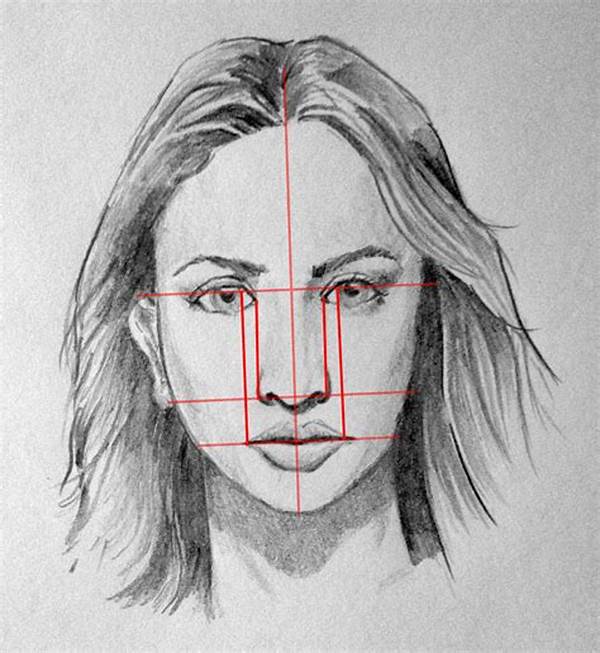Creating realistic portraiture is a delicate art form that demands a thorough understanding of proportions. The interplay of facial features, body structure, and subtle nuances all contribute to creating a lifelike representation. While talent and intuition play roles, mastering proportions is essential for artists striving for realism in their work.
Read Now : Cohesive Storytelling In Episodic Narratives
Understanding the Basics of Proportion
Proportions in realistic portraiture serve as the foundation for capturing the authenticity of the human form. In creating a portrait, the positioning and size of features such as the eyes, nose, and mouth are crucial. A small misplacement can alter the entire likeness of the subject. Understanding proportions not only involves the physical dimensions but also comprehends the relative distances and angles between each feature. An artist must practice and internalize these measurements to achieve accuracy and consistency.
Achieving realistic proportions in portraiture requires studying classical drawing techniques. For centuries, art educators have underscored the importance of understanding the human skull and its influence on facial structure. By mastering these anatomical basics, artists can interpret how light, shadow, and expression interplay on the human face. It’s not just about replicating what one sees but understanding how these elements work together to convey emotion and depth. Through proficiency in proportions, artists can capture the elusive essence of the individual they portray.
For those delving into realistic portraiture, tools like grids or drawing software can aid in maintaining correct proportions. However, they must never replace the value of keen observation and continuous practice. It’s essential to balance technical drawing skills with a sense of creativity to ensure the individuality of the portrait shines through. As artists gain confidence in their understanding of proportions, they find themselves able to convey both physical semblance and the inner essence of their subjects, rendering portraits alive and engaging.
Key Elements in Realistic Proportions
Understanding proportions in realistic portraiture involves dividing the face into equal sections for accurate placement.
The eyes are typically positioned halfway down the head, with space for one eye between them.
The bottom of the nose aligns with the midpoint between the eyes and chin.
The mouth’s corners are often aligned vertically with the center of the eyes.
The top of the ears generally lines up with the eyebrows, while the bottom aligns with the nose’s tip.
Challenges in Mastering Proportions
Mastering proportions in realistic portraiture presents unique challenges for artists. Fundamental misunderstanding or slight deviation can drastically affect the final result. A common difficulty is achieving symmetry while maintaining the unique characteristics that give a face its personality. Artists need to blend technical skills with an intuitive sense of the subject’s individuality.
Many artists emphasize the need for patience and practice in honing these skills. While it may be tempting to rush the process, careful observation and steady hands are essential. Artists might find it helpful to break down the learning process into manageable steps, concentrating on one aspect of the face at a time. By using techniques such as measuring with a pencil or ruler, they ensure accuracy in their work. As they conquer these challenges, artists can move towards creating portraits that genuinely resonate with their viewers.
Techniques to Improve Proportion Accuracy
1. Employ measurement techniques like the rule of thirds, aiding in feature placement.
2. Use grids to maintain proportion consistency across the canvas.
3. Practice drawing from life to sharpen observational skills.
4. Utilize anatomical sketches to understand bone and muscle structure.
5. Explore digital tools for trial and error without material waste.
6. Experiment with different scales to enhance spatial understanding.
Read Now : **nfts For Art Provenance Proof**
7. Analyze classic portrait artworks to learn successful techniques.
8. Attend workshops focusing on realistic rendering methods.
9. Incorporate feedback from peers and mentors to identify improvement areas.
10. Engage in continuous practice to solidify understanding and skill.
The Emotional Impact of Proportions
Proportions in realistic portraiture aren’t purely about mathematics but also about evoking emotions. When proportions are correctly captured, the essence of the subject can emerge, allowing viewers to connect with the artwork on a deeper level. A portrait with accurate proportions can convey the emotion, character, and story of the individual drawn, making it a powerful piece of art.
Artists skilled in maintaining proportions can guide the viewer’s attention and invoke emotional responses. The balance between technical accuracy and emotional depth is delicate, demanding both skill and empathy. Achieving this balance can transform a simple portrait into an evocative storytelling medium. By mastering proportions, artists help bridge the gap between their work and the audience’s imagination, making art an immersive experience.
Proportions in realistic portraiture are, therefore, an essential skill not just for maintaining likeness but also for encapsulating the nuanced expressions that convey the complexity of human emotions. This process requires more than simply fitting features together; it involves breathing life into them. The most revered portraits are those that resonate beyond their canvas, speaking to universal human emotion and experience through precise and thoughtful rendering of proportions.
Mastering the Nuances of Proportions
Achieving proficiency in proportions in realistic portraiture demands more than just technical skill; it requires a comprehensive understanding of the subject. Artists need to account for various factors such as age, ethnicity, and expressions that influence proportions. These nuances add layers of complexity to the portrait but also unveil a deeper connection with the viewer.
The pursuit of capturing these subtleties is a continuous journey. Artists often find that as their skill in this area grows, so does their ability to render diverse and compelling characters. The knowledge that each subject requires a unique approach adds a fulfilling dynamic to the art-making process. By exploring the diversity of human form through the lens of proportions, artists can create work that is both universally recognizable and deeply personal.
Ultimately, mastering proportions in realistic portraiture goes beyond mere replication. It requires a synthesis of observation, practice, and creativity. The journey to understanding and perfecting these elements allows artists to capture not just the external likeness, but also the internal life of their subjects, making their work resonate with authenticity and emotional depth.
The Journey to Perfect Proportions
While the journey to mastering proportions in realistic portraiture can be arduous, the rewards are immense. Producing an artwork that accurately represents the subject while also showcasing its unique personality is an artist’s aspiration. The process of refining these skills requires dedication, patience, and a willingness to learn from each creation.
Developing a keen eye for detail is crucial, as is cultivating a thoughtful approach to capturing the subtleties of the human face. Using techniques like anatomical studies or practicing drawing from life aids in building the essential foundation. Aspiring artists should immerse themselves in a range of practices, not only honing their technical skills but also nurturing a personal style that reflects their interpretation of their subjects.
Mastering proportions opens doors to an enriched artistic expression. The ability to capture a likeness while conveying emotion and personality is invaluable. By balancing precision with creativity, artists can give life to their work and produce pieces that strike a chord with viewers. This blending of technique and artistry ensures that their portraits aren’t just pictures, but captivating stories captured in time.



